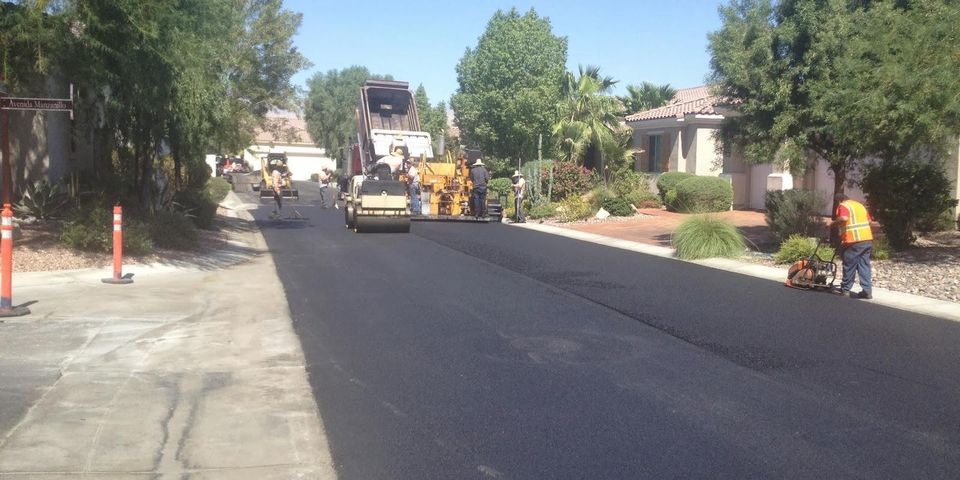Pavement Options - Rejuvenation, Resurfacing and Reconstruction - Property Management Tips from Hara Management, Inc.
By HMI

It’s seems to be such an obvious area of property maintenance and yet many HOA and Condominium Associations overlook important aspects of road maintenance. Failure to properly maintain the association's streets and/or parking areas can lead to increased expenses down the road - pun intended! HMI’s General Manager, Rick Michaud, recently interviewed Connie Lorenz, President of Asphalt Restoration Technology Systems, Inc. of Orlando about the various options with respect to road and parking lot maintenance.
When road maintenance is in order, your choices will likely come down to one of three options: rejuvenation, resurfacing or reconstruction.
1) REJUVENATING
Rejuvenating Pavements
Pavement rejuvenators are applied to existing aged or oxidized HMA pavements in order to restore pavement surface flexibility and to retard block cracking. Emulsified sealers, binders and rejuvenators are used in pavement preservation to protect oxidized asphalt surfaces or actually penetrate and rejuvenate them.
The oxidative aging of pavements begins at the time of construction and continues throughout a pavement's life. However, most aging occurs within the first two to four years of service life. This typically results in the top half-inch or so of the pavement surface becoming more brittle than the underlying material due to the actions of water and environment.
Rejuvenators are formulated to penetrate into the pavement and then enhance the properties of the asphalt binder of the existing pavement. Treatments should begin immediately after construction but more typically occur many years later when some form of distress is observed. Rejuvenation works by adding petroleum, a tar-based rejuvenator, to the road. Also, because it is made out of the same material as the old binder — tar surface — it penetrates old pavements while the properties in petroleum restore elasticity to the binder. However, while behaving as a life-extender for the road’s surface, rejuvenation only works if there is minimal surface loss and cracks covering less than 10% of the surface. Additionally, rejuvenation needs to be budgeted for approximately every 3-5 years.
Ms. Lorenz advised, “There are multiple types of rejuvenators on the market today ranging from soybean oil-based derivatives, coal tar-based mixes, maltene-based replacement, and, in some cases, products playing on the word “rejuvenation” but are really a water-based seal coat.
Some rejuvenators do have limitations as to when and where they should be applied; however, others on the market can and have been successfully applied to pavement more than 30 years old. Please be aware that the “clear” rejuvenators on the market may have speed limitations and should not be applied to pavement with speed limits that exceed 35-40 M.P.H.”
2) RESURFACING
Slurry Surfacing
A slurry surfacing, also known as a slurry seal, is not the same as a chip seal. Instead, it is a mixture of aggregates dispersed in an asphalt emulsion and applied in a slurry state. It is usually a mix of polymer-modified emulsion and fine crushed aggregate that is spread simultaneously in one pass over the street at a particular thickness. The slurry cures as the water evaporates, leaving only the asphalt to coat the aggregate.
Slurry surfacings are designed in a lab, are proportioned by a slurry machine, and laid down and cured so the asphalt-to-aggregate ratio is maintained at the optimum value to assure uniform aggregate coating and adhesion. Such friction courses use very large fractions of fine material, giving a very high surface area and a lot of microstructure, leading to a sandpaper surface and a high skid resistance while maintaining a smooth finish.
A variant of the slurry surfacing is microsurfacing, which is a mix of polymer-modified asphalt emulsion, mineral aggregate, mineral filler, water, and other additives, which is proportioned, mixed, and spread on a paved surface. Microsurfacing differs from slurry seal in that it can be used on high volume roadways to correct wheel path rutting and provide a skid-resistant pavement surface.
Pavement Surfacing
Pavement resurfacing (also known as an overlay, asphalt overlay or pavement overlay) is the process of installing a new layer of asphalt over the existing pavement. This new layer is generally 1.5 – 2 inch in depth.
3) RECONSTRUCTION
Pavement reconstruction can include installing both the subgrade asphalt layer as well as the top pavement overlay layer depending on the condition of the existing pavement. If the existing pavement is in good condition prior to an overlay, a contractor can scarify the surface and install the new overlay thereby add additional stability and strength to the existing pavement.
If the existing asphalt cap is severely raveled and cracked but no visual sub base issues, a contractor might recommend that you mill out the asphalt cap to the sub base and install the new overlay on top. This will slow down the reflective cracking in the new asphalt cap.
If the existing asphalt cap is severely raveled and there are obvious signs of sub base issues such as alligatoring or shoving, a contractor will recommend full depth reconstruction that includes removing the existing asphalt cap and reworking the top 6" to 12" of the sub base and re-compacting it prior to installing the new overlay would produce the best results for that pavement.
A note of caution about the term “resealing” from Asphalt Restoration Technology Systems
Ms. Lorenz noted that “resealing” can be a vague term representing either a water-based emulsion such as sealcoating or an oil-based rejuvenator. She says, “They are commonly referenced together because they both turn the pavement black; however, after that, they are quite different.
Water based emulsions such as sealcoating is the least expensive of surface treatments and is known as a ‘sacrificial surface’. These are typically 2-3 pounds of sand per gallon mixed with about 30-35% water and can be sprayed on or squeegeed on. These products are designed to block the damage from oxidation while in place, and are typically applied every 1 to 2 years.
Oil based products such as asphalt rejuvenators are designed to actually penetrate your pavement and replace or replenish the maltene portion of the asphalt binder that is subjected to degradation due to oxidation. These products are designed to extend the life of your pavement and are only applied to pavement that has not been previously treated in the past.
We have worked with properties that had both sealcoated and rejuvenated roadways and found that over a six-year period, the sealcoated roads we treated (3) times to every (1) application of our rejuvenation products”, Lorenz added.
What about the impact of falling oil prices?
Knowing that there’s been a lot of discussion on this topic, we asked Ms. Lorenz about the impact of falling oil prices on the cost of road maintenance materials: “We rarely, if ever, see a decrease in price when we see a fuel prices drop - as it fluctuates so much. It's a shame as we really should, but since price is determined a year in advance for oils, gas prices would have to stay super low for roughly nine months for it to start to show an impact. The recent fuel prices are a good example – they quickly dropped the past couple months down to around $1.94/gallon, and that lasted just a few weeks, with gas prices rebounding back up to around $2.39/gallon. There’s just too much market fluctuation for asphalt producers to commoditize their prices, short of a long term cost drop”.
So, which to choose?
In today's market, typical water based sealcoats can average anywhere from $.85 per square yard and up, rejuvenators can range between $1.50 and up, slurry seals and micro surfacing can run around $5.00 per square yard but these numbers vary based on the size of the property and the number of days required to complete the project.
When it comes to new overlays, a 1" compacted overlay can run about $8.00 per square yard, add about another $2.00 per yard for milling and double that price for full depth reclamation. Remember though that these prices do not include repairs, striping, signage, or specialty work such as painting wheelstops or stenciling. If you live on an island, be prepared to pay a higher price as bridge weight limits can require additional trucking due to lighter loads traveling over to the island.
While there is a significant investment related to pavement maintenance, consider that roughly 15 miles of rejuvenation will cost upwards of $300,000; adding a 1" overlay would cost around $1.6 million, while the cost of reconstructing the same mileage will cost, on average, around $3 million, but will last for another 15 years.
The bottom line – if your road surfaces are in good shape, in the long run it pays to maintain them. Even with repeated asphalt rejuvenation; it’s still the cheaper option for extending the life of your pavement, versus letting the roads deteriorate to the point where a more expensive option is required. If, however, your roads have suffered significant damage, any money spent on rejuvenation is an utter waste, since it simply cannot recoup extensive damage. Rejuvenators are amazing products but they are not miracle workers, therefore if your road is in bad shape, rejuvenation is not for you.
Hara Management, Inc., Central Florida's premier Association Management and Property Management firm would be happy to assist you with researching and selecting a vendor for your next community project.
Article sources and contributors:
- Ms. Connie Lorenz, President of Asphalt Restoration Technology Systems, Inc. – Orlando, FL. http://www.asphaltnews.com/index.html
- http://www.totalasphalt.com/docs/about_us/Rejuvenation-vs-Re-paving_Drum-Point.pdf
- http://www.condo-smart.com/understanding-asphalt-repairs/
About the Business
Have a question? Ask the experts!
Send your question

